Steve Jobs vs Tim Cook Leadership Styles
VerifiedAdded on 2020/05/11
|14
|2523
|202
AI Summary
This assignment examines the distinct leadership styles of Steve Jobs and Tim Cook at Apple. It analyzes Jobs' charisma, innovation focus, and visionary approach, contrasting it with Cook's emphasis on operational excellence, management skills, and sustainability. The document explores how both leaders contributed to Apple's success and highlights the evolution of leadership within the company.
Contribute Materials
Your contribution can guide someone’s learning journey. Share your
documents today.
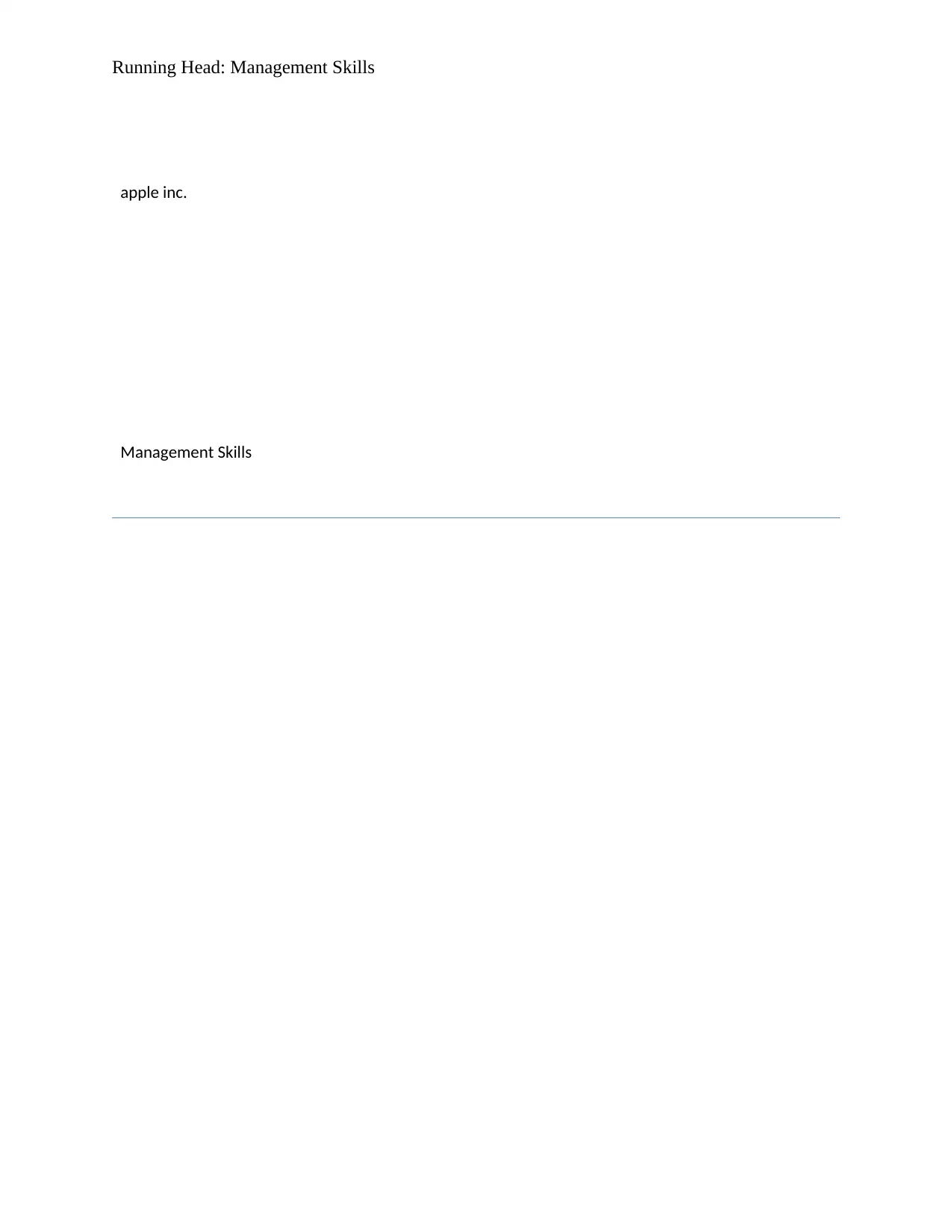
Running Head: Management Skills
apple inc.
Management Skills
apple inc.
Management Skills
Secure Best Marks with AI Grader
Need help grading? Try our AI Grader for instant feedback on your assignments.
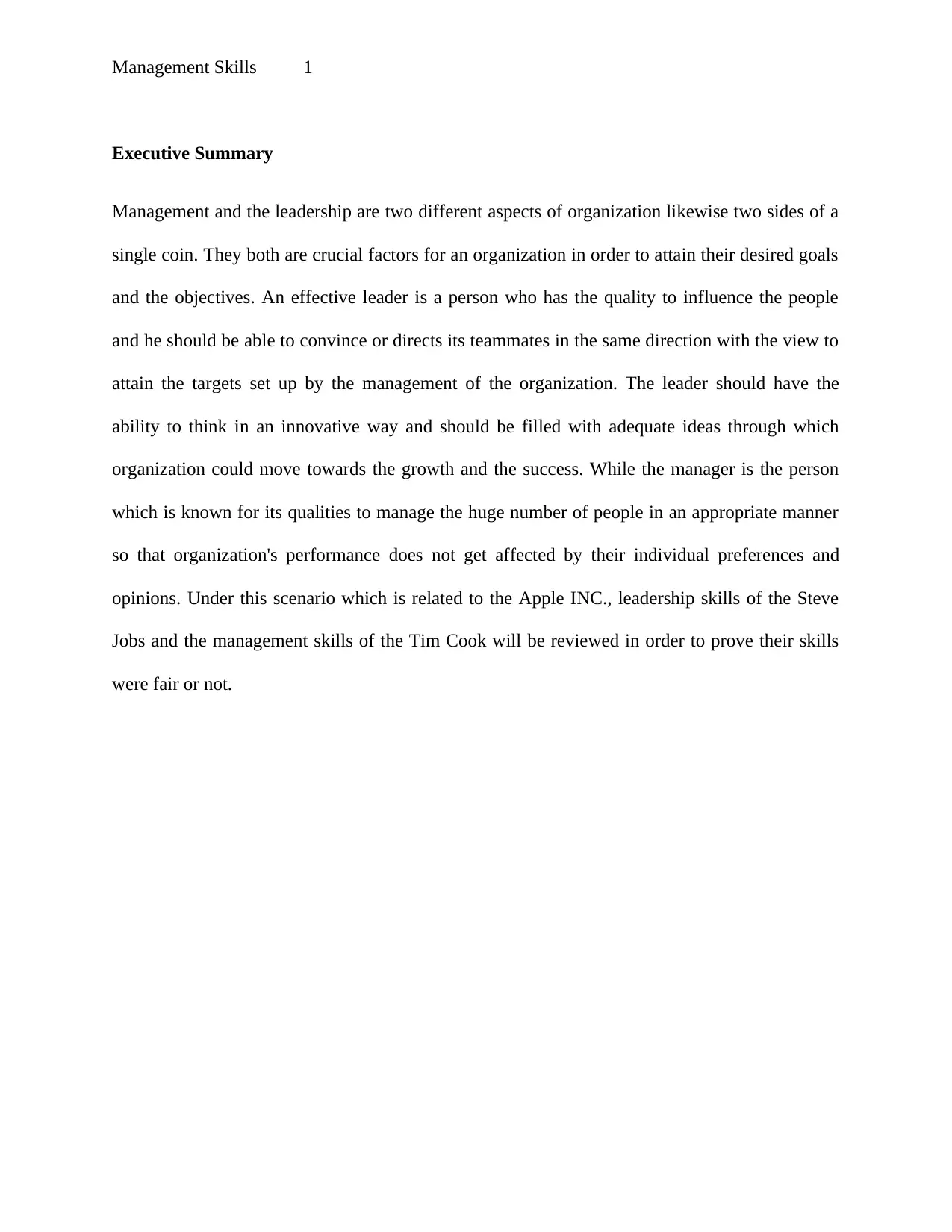
Management Skills 1
Executive Summary
Management and the leadership are two different aspects of organization likewise two sides of a
single coin. They both are crucial factors for an organization in order to attain their desired goals
and the objectives. An effective leader is a person who has the quality to influence the people
and he should be able to convince or directs its teammates in the same direction with the view to
attain the targets set up by the management of the organization. The leader should have the
ability to think in an innovative way and should be filled with adequate ideas through which
organization could move towards the growth and the success. While the manager is the person
which is known for its qualities to manage the huge number of people in an appropriate manner
so that organization's performance does not get affected by their individual preferences and
opinions. Under this scenario which is related to the Apple INC., leadership skills of the Steve
Jobs and the management skills of the Tim Cook will be reviewed in order to prove their skills
were fair or not.
Executive Summary
Management and the leadership are two different aspects of organization likewise two sides of a
single coin. They both are crucial factors for an organization in order to attain their desired goals
and the objectives. An effective leader is a person who has the quality to influence the people
and he should be able to convince or directs its teammates in the same direction with the view to
attain the targets set up by the management of the organization. The leader should have the
ability to think in an innovative way and should be filled with adequate ideas through which
organization could move towards the growth and the success. While the manager is the person
which is known for its qualities to manage the huge number of people in an appropriate manner
so that organization's performance does not get affected by their individual preferences and
opinions. Under this scenario which is related to the Apple INC., leadership skills of the Steve
Jobs and the management skills of the Tim Cook will be reviewed in order to prove their skills
were fair or not.
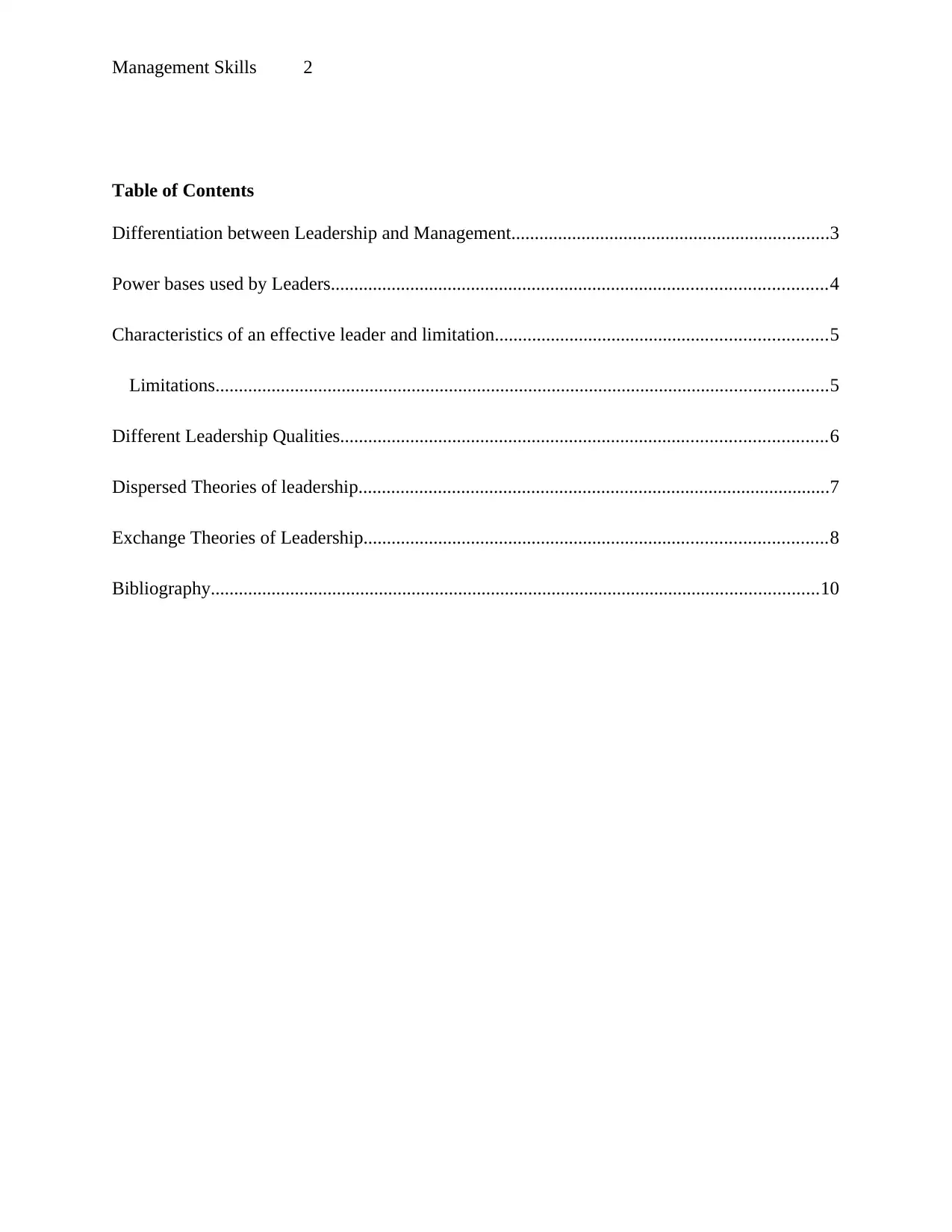
Management Skills 2
Table of Contents
Differentiation between Leadership and Management....................................................................3
Power bases used by Leaders..........................................................................................................4
Characteristics of an effective leader and limitation.......................................................................5
Limitations...................................................................................................................................5
Different Leadership Qualities........................................................................................................6
Dispersed Theories of leadership.....................................................................................................7
Exchange Theories of Leadership...................................................................................................8
Bibliography..................................................................................................................................10
Table of Contents
Differentiation between Leadership and Management....................................................................3
Power bases used by Leaders..........................................................................................................4
Characteristics of an effective leader and limitation.......................................................................5
Limitations...................................................................................................................................5
Different Leadership Qualities........................................................................................................6
Dispersed Theories of leadership.....................................................................................................7
Exchange Theories of Leadership...................................................................................................8
Bibliography..................................................................................................................................10

Management Skills 3
Differentiation between Leadership and Management
Leaders (Steve Jobs) Managers (Tim Cook)
Steve Jobs was an active and curious
person and he was quite good at
planning and organizing the activities.
As Tim Cook has overtaken the
position of the founder of Apple INC.,
he has shown his skills and talent in
order to support the existing employees
of the organization so that Apple INC.1
could attain outstanding growth in the
business environment.
Steve Jobs was a personality with
various solutions for a single issue.
When Apple INC. was at the
diminishing stage, he was the person
who showed his unique skills to
manufacture ultimate electronic
consumer goods and gadgets.2 Due to
this Apple INC. is enjoying huge
success today.
While evaluating the qualities of Tim
Cook and Steve Jobs, they both are
exceptional for their places. Today,
Apple INC. is at the peak place but
still, it suffers from various issues but
Tim Cook has the ability to resolve
those issues quickly so that
organization’s performance does not
get affected.
Steve Jobs was so motivating and it Tim Cook has taken the responsibility
1 Aaker, D.A. & Joachimsthaler, E., 2012, “Simon and Schuster”, Brand leadership.
2 Akana, J., Andre, B.K., Bataillou, J., Coster, D.J., De Iuliis, D., Hankey, E., Howarth, R.P., Ive,
J.P., Jobs, S., Kerr, D.R. & Nishibori, S., 2011, “Patent D642”, Electronic device. U.S., pp. 563.
Differentiation between Leadership and Management
Leaders (Steve Jobs) Managers (Tim Cook)
Steve Jobs was an active and curious
person and he was quite good at
planning and organizing the activities.
As Tim Cook has overtaken the
position of the founder of Apple INC.,
he has shown his skills and talent in
order to support the existing employees
of the organization so that Apple INC.1
could attain outstanding growth in the
business environment.
Steve Jobs was a personality with
various solutions for a single issue.
When Apple INC. was at the
diminishing stage, he was the person
who showed his unique skills to
manufacture ultimate electronic
consumer goods and gadgets.2 Due to
this Apple INC. is enjoying huge
success today.
While evaluating the qualities of Tim
Cook and Steve Jobs, they both are
exceptional for their places. Today,
Apple INC. is at the peak place but
still, it suffers from various issues but
Tim Cook has the ability to resolve
those issues quickly so that
organization’s performance does not
get affected.
Steve Jobs was so motivating and it Tim Cook has taken the responsibility
1 Aaker, D.A. & Joachimsthaler, E., 2012, “Simon and Schuster”, Brand leadership.
2 Akana, J., Andre, B.K., Bataillou, J., Coster, D.J., De Iuliis, D., Hankey, E., Howarth, R.P., Ive,
J.P., Jobs, S., Kerr, D.R. & Nishibori, S., 2011, “Patent D642”, Electronic device. U.S., pp. 563.
Secure Best Marks with AI Grader
Need help grading? Try our AI Grader for instant feedback on your assignments.
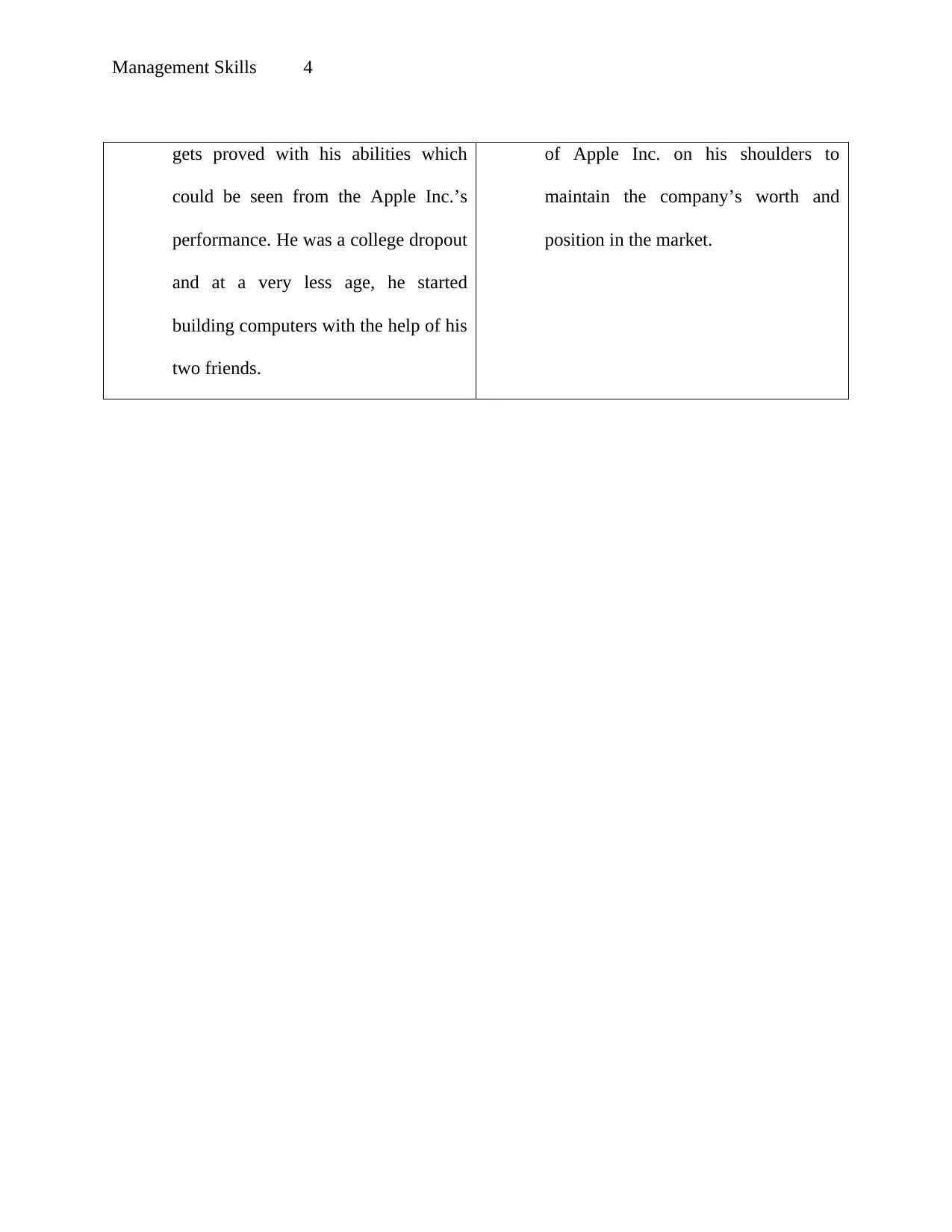
Management Skills 4
gets proved with his abilities which
could be seen from the Apple Inc.’s
performance. He was a college dropout
and at a very less age, he started
building computers with the help of his
two friends.
of Apple Inc. on his shoulders to
maintain the company’s worth and
position in the market.
gets proved with his abilities which
could be seen from the Apple Inc.’s
performance. He was a college dropout
and at a very less age, he started
building computers with the help of his
two friends.
of Apple Inc. on his shoulders to
maintain the company’s worth and
position in the market.
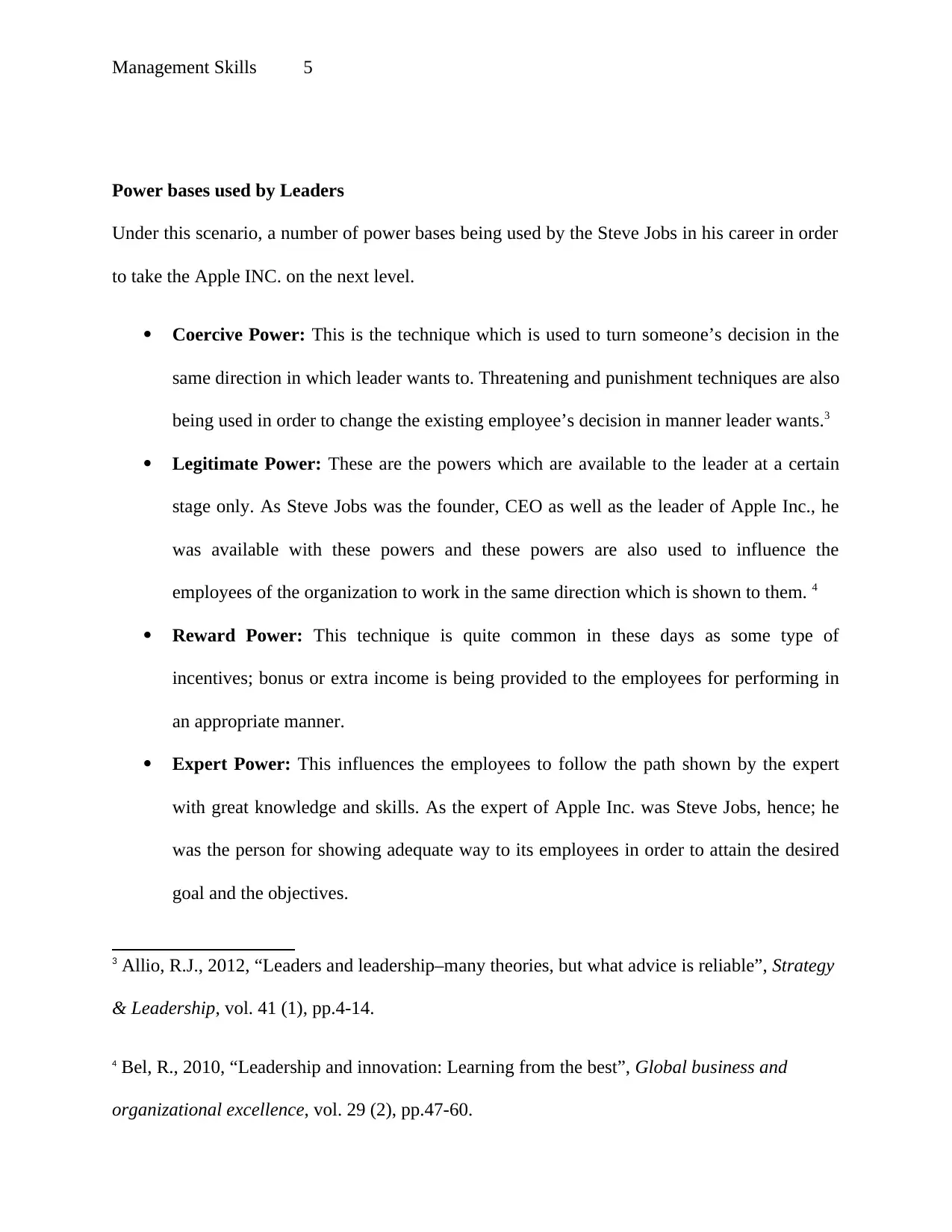
Management Skills 5
Power bases used by Leaders
Under this scenario, a number of power bases being used by the Steve Jobs in his career in order
to take the Apple INC. on the next level.
Coercive Power: This is the technique which is used to turn someone’s decision in the
same direction in which leader wants to. Threatening and punishment techniques are also
being used in order to change the existing employee’s decision in manner leader wants.3
Legitimate Power: These are the powers which are available to the leader at a certain
stage only. As Steve Jobs was the founder, CEO as well as the leader of Apple Inc., he
was available with these powers and these powers are also used to influence the
employees of the organization to work in the same direction which is shown to them. 4
Reward Power: This technique is quite common in these days as some type of
incentives; bonus or extra income is being provided to the employees for performing in
an appropriate manner.
Expert Power: This influences the employees to follow the path shown by the expert
with great knowledge and skills. As the expert of Apple Inc. was Steve Jobs, hence; he
was the person for showing adequate way to its employees in order to attain the desired
goal and the objectives.
3 Allio, R.J., 2012, “Leaders and leadership–many theories, but what advice is reliable”, Strategy
& Leadership, vol. 41 (1), pp.4-14.
4 Bel, R., 2010, “Leadership and innovation: Learning from the best”, Global business and
organizational excellence, vol. 29 (2), pp.47-60.
Power bases used by Leaders
Under this scenario, a number of power bases being used by the Steve Jobs in his career in order
to take the Apple INC. on the next level.
Coercive Power: This is the technique which is used to turn someone’s decision in the
same direction in which leader wants to. Threatening and punishment techniques are also
being used in order to change the existing employee’s decision in manner leader wants.3
Legitimate Power: These are the powers which are available to the leader at a certain
stage only. As Steve Jobs was the founder, CEO as well as the leader of Apple Inc., he
was available with these powers and these powers are also used to influence the
employees of the organization to work in the same direction which is shown to them. 4
Reward Power: This technique is quite common in these days as some type of
incentives; bonus or extra income is being provided to the employees for performing in
an appropriate manner.
Expert Power: This influences the employees to follow the path shown by the expert
with great knowledge and skills. As the expert of Apple Inc. was Steve Jobs, hence; he
was the person for showing adequate way to its employees in order to attain the desired
goal and the objectives.
3 Allio, R.J., 2012, “Leaders and leadership–many theories, but what advice is reliable”, Strategy
& Leadership, vol. 41 (1), pp.4-14.
4 Bel, R., 2010, “Leadership and innovation: Learning from the best”, Global business and
organizational excellence, vol. 29 (2), pp.47-60.
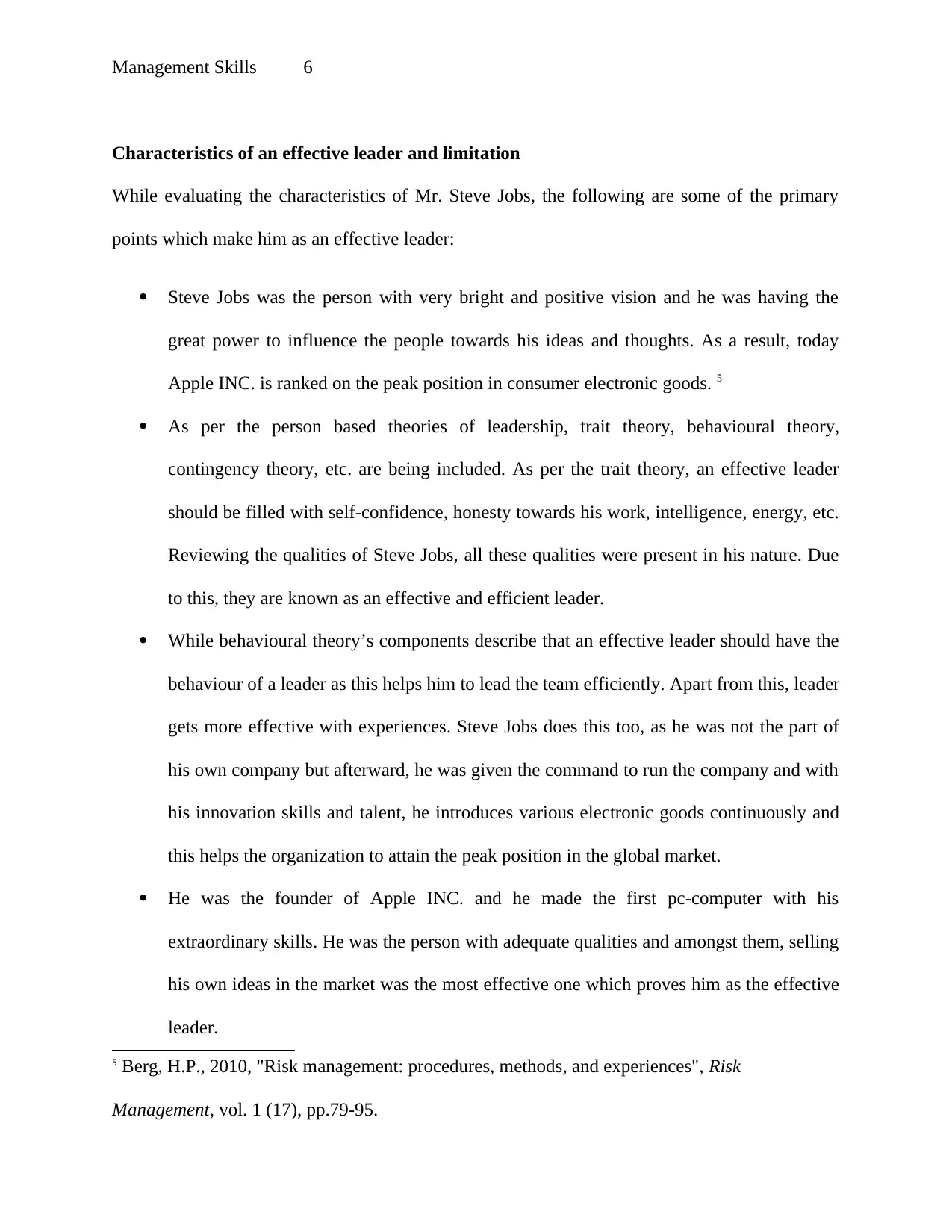
Management Skills 6
Characteristics of an effective leader and limitation
While evaluating the characteristics of Mr. Steve Jobs, the following are some of the primary
points which make him as an effective leader:
Steve Jobs was the person with very bright and positive vision and he was having the
great power to influence the people towards his ideas and thoughts. As a result, today
Apple INC. is ranked on the peak position in consumer electronic goods. 5
As per the person based theories of leadership, trait theory, behavioural theory,
contingency theory, etc. are being included. As per the trait theory, an effective leader
should be filled with self-confidence, honesty towards his work, intelligence, energy, etc.
Reviewing the qualities of Steve Jobs, all these qualities were present in his nature. Due
to this, they are known as an effective and efficient leader.
While behavioural theory’s components describe that an effective leader should have the
behaviour of a leader as this helps him to lead the team efficiently. Apart from this, leader
gets more effective with experiences. Steve Jobs does this too, as he was not the part of
his own company but afterward, he was given the command to run the company and with
his innovation skills and talent, he introduces various electronic goods continuously and
this helps the organization to attain the peak position in the global market.
He was the founder of Apple INC. and he made the first pc-computer with his
extraordinary skills. He was the person with adequate qualities and amongst them, selling
his own ideas in the market was the most effective one which proves him as the effective
leader.
5 Berg, H.P., 2010, "Risk management: procedures, methods, and experiences", Risk
Management, vol. 1 (17), pp.79-95.
Characteristics of an effective leader and limitation
While evaluating the characteristics of Mr. Steve Jobs, the following are some of the primary
points which make him as an effective leader:
Steve Jobs was the person with very bright and positive vision and he was having the
great power to influence the people towards his ideas and thoughts. As a result, today
Apple INC. is ranked on the peak position in consumer electronic goods. 5
As per the person based theories of leadership, trait theory, behavioural theory,
contingency theory, etc. are being included. As per the trait theory, an effective leader
should be filled with self-confidence, honesty towards his work, intelligence, energy, etc.
Reviewing the qualities of Steve Jobs, all these qualities were present in his nature. Due
to this, they are known as an effective and efficient leader.
While behavioural theory’s components describe that an effective leader should have the
behaviour of a leader as this helps him to lead the team efficiently. Apart from this, leader
gets more effective with experiences. Steve Jobs does this too, as he was not the part of
his own company but afterward, he was given the command to run the company and with
his innovation skills and talent, he introduces various electronic goods continuously and
this helps the organization to attain the peak position in the global market.
He was the founder of Apple INC. and he made the first pc-computer with his
extraordinary skills. He was the person with adequate qualities and amongst them, selling
his own ideas in the market was the most effective one which proves him as the effective
leader.
5 Berg, H.P., 2010, "Risk management: procedures, methods, and experiences", Risk
Management, vol. 1 (17), pp.79-95.
Paraphrase This Document
Need a fresh take? Get an instant paraphrase of this document with our AI Paraphraser
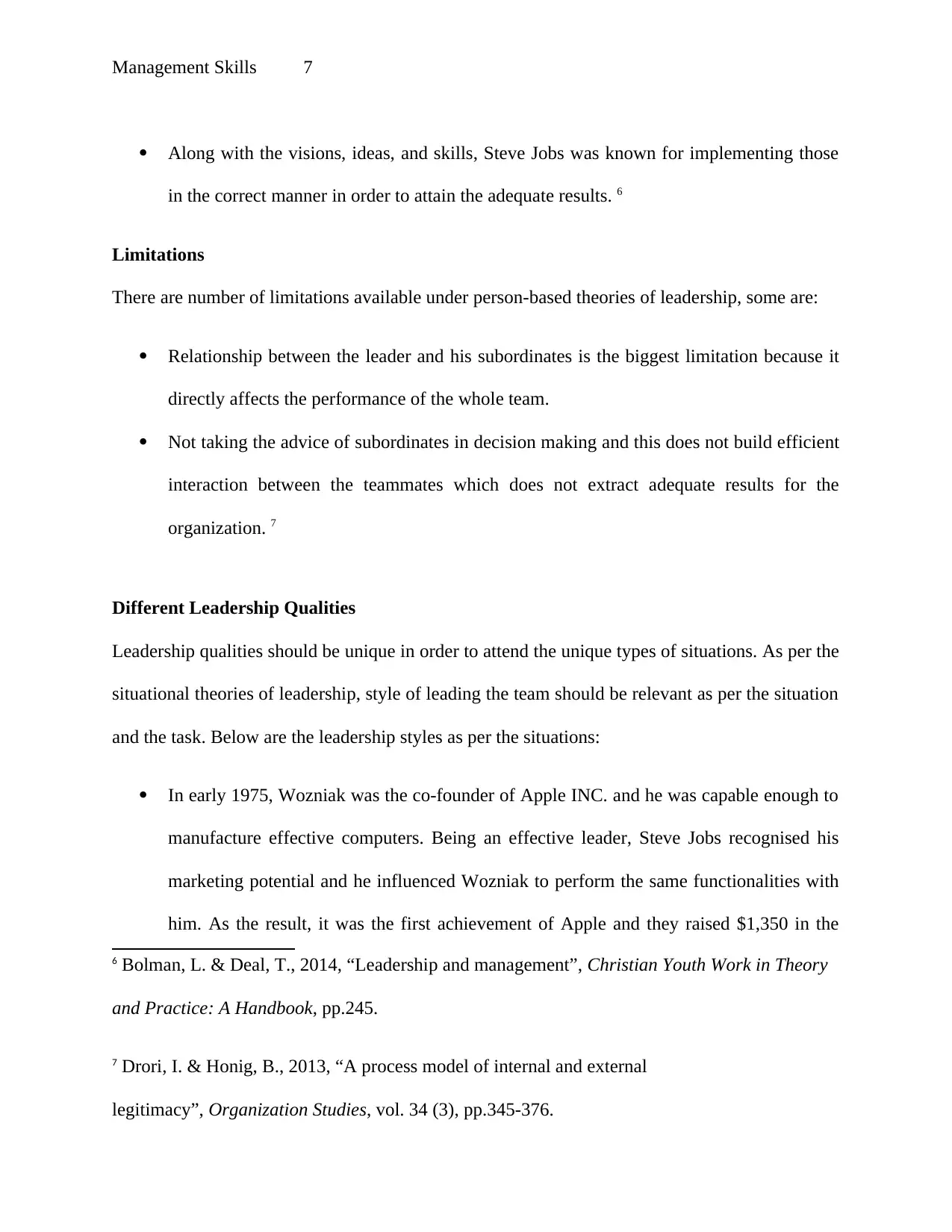
Management Skills 7
Along with the visions, ideas, and skills, Steve Jobs was known for implementing those
in the correct manner in order to attain the adequate results. 6
Limitations
There are number of limitations available under person-based theories of leadership, some are:
Relationship between the leader and his subordinates is the biggest limitation because it
directly affects the performance of the whole team.
Not taking the advice of subordinates in decision making and this does not build efficient
interaction between the teammates which does not extract adequate results for the
organization. 7
Different Leadership Qualities
Leadership qualities should be unique in order to attend the unique types of situations. As per the
situational theories of leadership, style of leading the team should be relevant as per the situation
and the task. Below are the leadership styles as per the situations:
In early 1975, Wozniak was the co-founder of Apple INC. and he was capable enough to
manufacture effective computers. Being an effective leader, Steve Jobs recognised his
marketing potential and he influenced Wozniak to perform the same functionalities with
him. As the result, it was the first achievement of Apple and they raised $1,350 in the
6 Bolman, L. & Deal, T., 2014, “Leadership and management”, Christian Youth Work in Theory
and Practice: A Handbook, pp.245.
7 Drori, I. & Honig, B., 2013, “A process model of internal and external
legitimacy”, Organization Studies, vol. 34 (3), pp.345-376.
Along with the visions, ideas, and skills, Steve Jobs was known for implementing those
in the correct manner in order to attain the adequate results. 6
Limitations
There are number of limitations available under person-based theories of leadership, some are:
Relationship between the leader and his subordinates is the biggest limitation because it
directly affects the performance of the whole team.
Not taking the advice of subordinates in decision making and this does not build efficient
interaction between the teammates which does not extract adequate results for the
organization. 7
Different Leadership Qualities
Leadership qualities should be unique in order to attend the unique types of situations. As per the
situational theories of leadership, style of leading the team should be relevant as per the situation
and the task. Below are the leadership styles as per the situations:
In early 1975, Wozniak was the co-founder of Apple INC. and he was capable enough to
manufacture effective computers. Being an effective leader, Steve Jobs recognised his
marketing potential and he influenced Wozniak to perform the same functionalities with
him. As the result, it was the first achievement of Apple and they raised $1,350 in the
6 Bolman, L. & Deal, T., 2014, “Leadership and management”, Christian Youth Work in Theory
and Practice: A Handbook, pp.245.
7 Drori, I. & Honig, B., 2013, “A process model of internal and external
legitimacy”, Organization Studies, vol. 34 (3), pp.345-376.
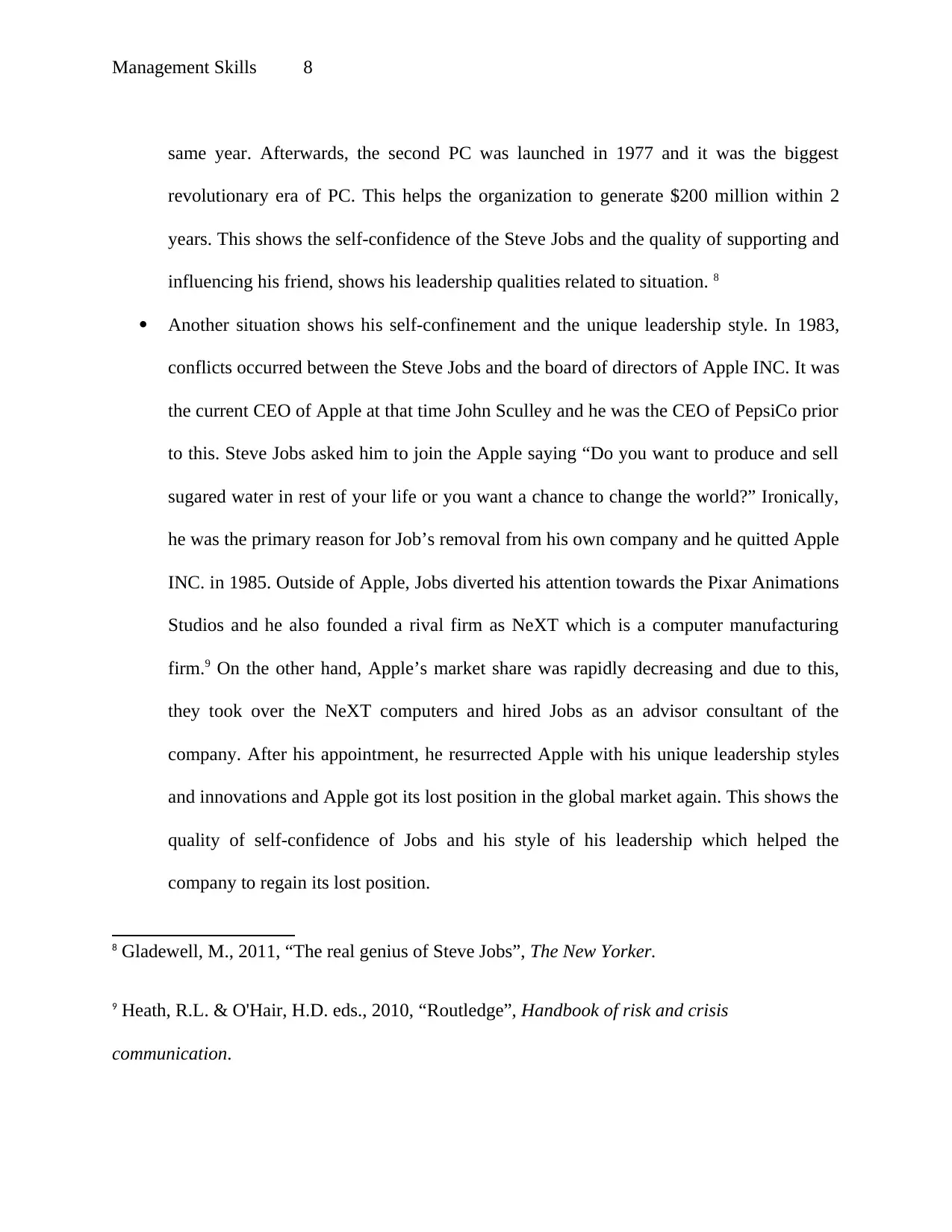
Management Skills 8
same year. Afterwards, the second PC was launched in 1977 and it was the biggest
revolutionary era of PC. This helps the organization to generate $200 million within 2
years. This shows the self-confidence of the Steve Jobs and the quality of supporting and
influencing his friend, shows his leadership qualities related to situation. 8
Another situation shows his self-confinement and the unique leadership style. In 1983,
conflicts occurred between the Steve Jobs and the board of directors of Apple INC. It was
the current CEO of Apple at that time John Sculley and he was the CEO of PepsiCo prior
to this. Steve Jobs asked him to join the Apple saying “Do you want to produce and sell
sugared water in rest of your life or you want a chance to change the world?” Ironically,
he was the primary reason for Job’s removal from his own company and he quitted Apple
INC. in 1985. Outside of Apple, Jobs diverted his attention towards the Pixar Animations
Studios and he also founded a rival firm as NeXT which is a computer manufacturing
firm.9 On the other hand, Apple’s market share was rapidly decreasing and due to this,
they took over the NeXT computers and hired Jobs as an advisor consultant of the
company. After his appointment, he resurrected Apple with his unique leadership styles
and innovations and Apple got its lost position in the global market again. This shows the
quality of self-confidence of Jobs and his style of his leadership which helped the
company to regain its lost position.
8 Gladewell, M., 2011, “The real genius of Steve Jobs”, The New Yorker.
9 Heath, R.L. & O'Hair, H.D. eds., 2010, “Routledge”, Handbook of risk and crisis
communication.
same year. Afterwards, the second PC was launched in 1977 and it was the biggest
revolutionary era of PC. This helps the organization to generate $200 million within 2
years. This shows the self-confidence of the Steve Jobs and the quality of supporting and
influencing his friend, shows his leadership qualities related to situation. 8
Another situation shows his self-confinement and the unique leadership style. In 1983,
conflicts occurred between the Steve Jobs and the board of directors of Apple INC. It was
the current CEO of Apple at that time John Sculley and he was the CEO of PepsiCo prior
to this. Steve Jobs asked him to join the Apple saying “Do you want to produce and sell
sugared water in rest of your life or you want a chance to change the world?” Ironically,
he was the primary reason for Job’s removal from his own company and he quitted Apple
INC. in 1985. Outside of Apple, Jobs diverted his attention towards the Pixar Animations
Studios and he also founded a rival firm as NeXT which is a computer manufacturing
firm.9 On the other hand, Apple’s market share was rapidly decreasing and due to this,
they took over the NeXT computers and hired Jobs as an advisor consultant of the
company. After his appointment, he resurrected Apple with his unique leadership styles
and innovations and Apple got its lost position in the global market again. This shows the
quality of self-confidence of Jobs and his style of his leadership which helped the
company to regain its lost position.
8 Gladewell, M., 2011, “The real genius of Steve Jobs”, The New Yorker.
9 Heath, R.L. & O'Hair, H.D. eds., 2010, “Routledge”, Handbook of risk and crisis
communication.

Management Skills 9
Secure Best Marks with AI Grader
Need help grading? Try our AI Grader for instant feedback on your assignments.
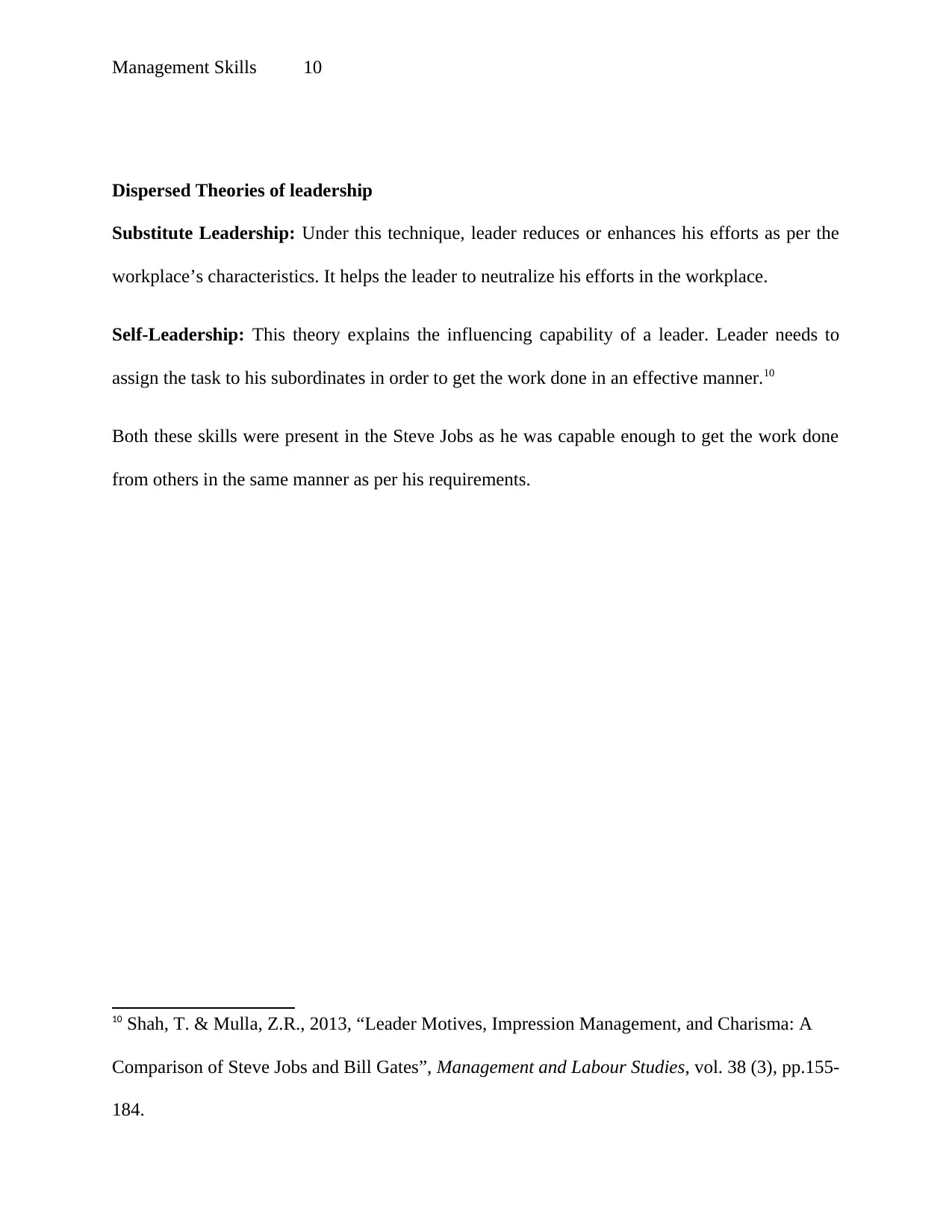
Management Skills 10
Dispersed Theories of leadership
Substitute Leadership: Under this technique, leader reduces or enhances his efforts as per the
workplace’s characteristics. It helps the leader to neutralize his efforts in the workplace.
Self-Leadership: This theory explains the influencing capability of a leader. Leader needs to
assign the task to his subordinates in order to get the work done in an effective manner.10
Both these skills were present in the Steve Jobs as he was capable enough to get the work done
from others in the same manner as per his requirements.
10 Shah, T. & Mulla, Z.R., 2013, “Leader Motives, Impression Management, and Charisma: A
Comparison of Steve Jobs and Bill Gates”, Management and Labour Studies, vol. 38 (3), pp.155-
184.
Dispersed Theories of leadership
Substitute Leadership: Under this technique, leader reduces or enhances his efforts as per the
workplace’s characteristics. It helps the leader to neutralize his efforts in the workplace.
Self-Leadership: This theory explains the influencing capability of a leader. Leader needs to
assign the task to his subordinates in order to get the work done in an effective manner.10
Both these skills were present in the Steve Jobs as he was capable enough to get the work done
from others in the same manner as per his requirements.
10 Shah, T. & Mulla, Z.R., 2013, “Leader Motives, Impression Management, and Charisma: A
Comparison of Steve Jobs and Bill Gates”, Management and Labour Studies, vol. 38 (3), pp.155-
184.
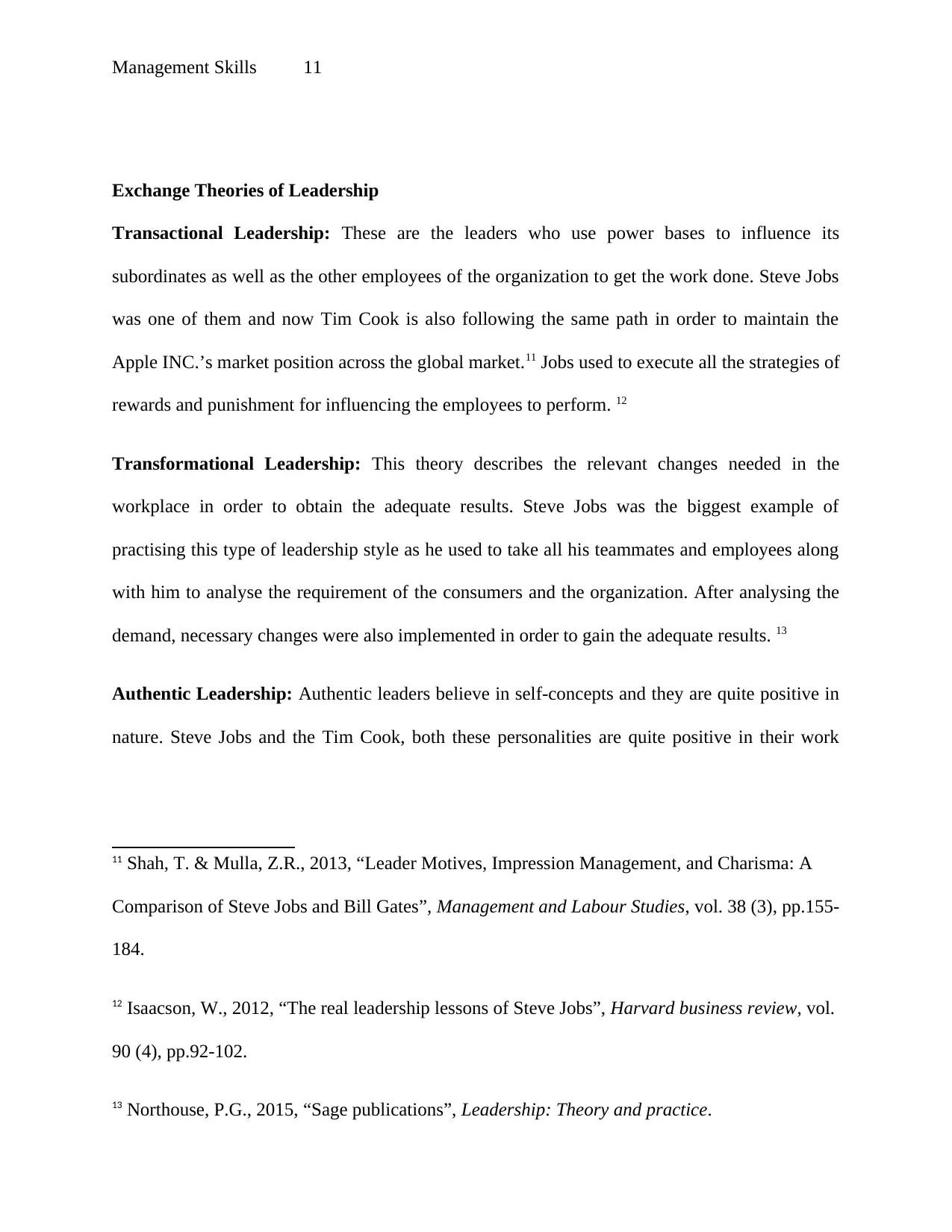
Management Skills 11
Exchange Theories of Leadership
Transactional Leadership: These are the leaders who use power bases to influence its
subordinates as well as the other employees of the organization to get the work done. Steve Jobs
was one of them and now Tim Cook is also following the same path in order to maintain the
Apple INC.’s market position across the global market.11 Jobs used to execute all the strategies of
rewards and punishment for influencing the employees to perform. 12
Transformational Leadership: This theory describes the relevant changes needed in the
workplace in order to obtain the adequate results. Steve Jobs was the biggest example of
practising this type of leadership style as he used to take all his teammates and employees along
with him to analyse the requirement of the consumers and the organization. After analysing the
demand, necessary changes were also implemented in order to gain the adequate results. 13
Authentic Leadership: Authentic leaders believe in self-concepts and they are quite positive in
nature. Steve Jobs and the Tim Cook, both these personalities are quite positive in their work
11 Shah, T. & Mulla, Z.R., 2013, “Leader Motives, Impression Management, and Charisma: A
Comparison of Steve Jobs and Bill Gates”, Management and Labour Studies, vol. 38 (3), pp.155-
184.
12 Isaacson, W., 2012, “The real leadership lessons of Steve Jobs”, Harvard business review, vol.
90 (4), pp.92-102.
13 Northouse, P.G., 2015, “Sage publications”, Leadership: Theory and practice.
Exchange Theories of Leadership
Transactional Leadership: These are the leaders who use power bases to influence its
subordinates as well as the other employees of the organization to get the work done. Steve Jobs
was one of them and now Tim Cook is also following the same path in order to maintain the
Apple INC.’s market position across the global market.11 Jobs used to execute all the strategies of
rewards and punishment for influencing the employees to perform. 12
Transformational Leadership: This theory describes the relevant changes needed in the
workplace in order to obtain the adequate results. Steve Jobs was the biggest example of
practising this type of leadership style as he used to take all his teammates and employees along
with him to analyse the requirement of the consumers and the organization. After analysing the
demand, necessary changes were also implemented in order to gain the adequate results. 13
Authentic Leadership: Authentic leaders believe in self-concepts and they are quite positive in
nature. Steve Jobs and the Tim Cook, both these personalities are quite positive in their work
11 Shah, T. & Mulla, Z.R., 2013, “Leader Motives, Impression Management, and Charisma: A
Comparison of Steve Jobs and Bill Gates”, Management and Labour Studies, vol. 38 (3), pp.155-
184.
12 Isaacson, W., 2012, “The real leadership lessons of Steve Jobs”, Harvard business review, vol.
90 (4), pp.92-102.
13 Northouse, P.G., 2015, “Sage publications”, Leadership: Theory and practice.
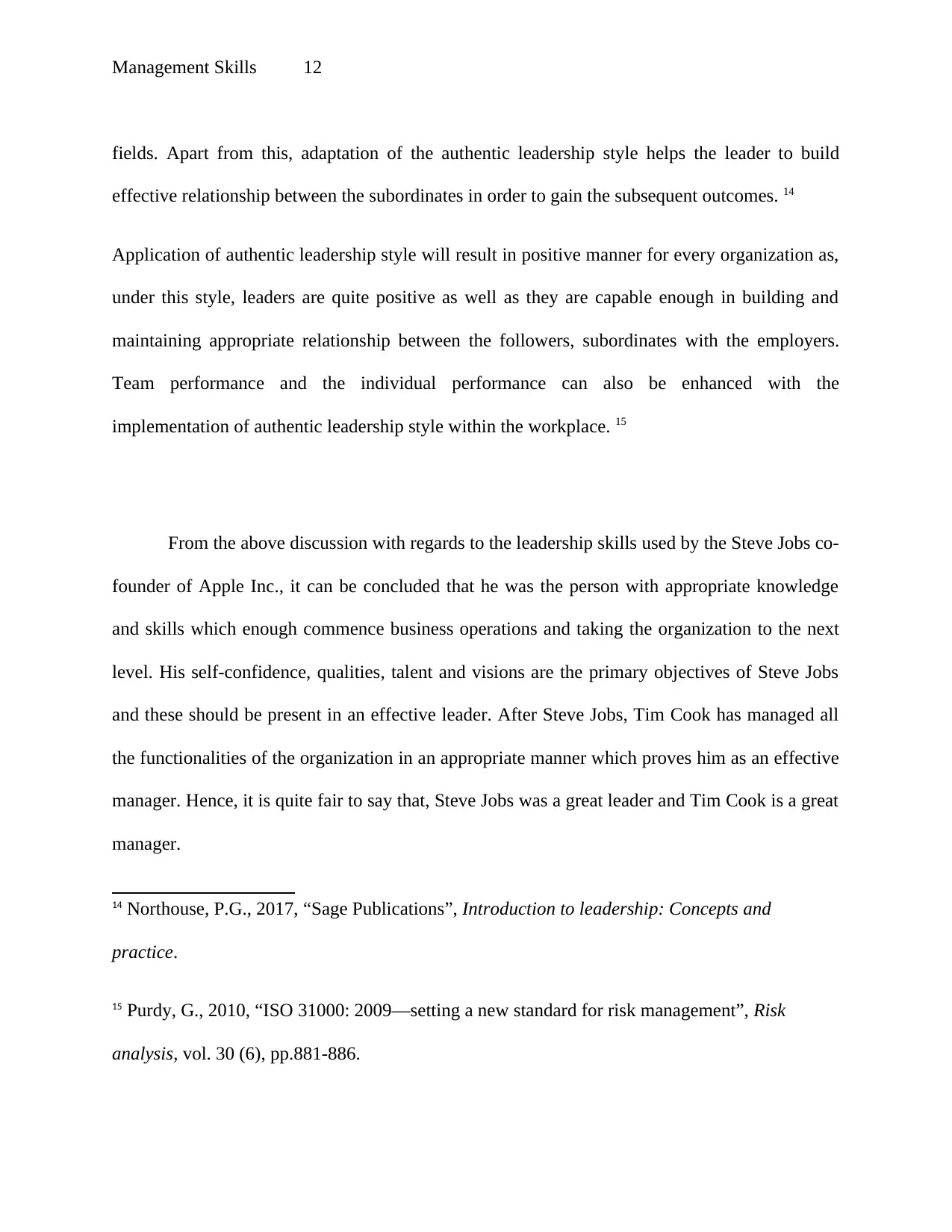
Management Skills 12
fields. Apart from this, adaptation of the authentic leadership style helps the leader to build
effective relationship between the subordinates in order to gain the subsequent outcomes. 14
Application of authentic leadership style will result in positive manner for every organization as,
under this style, leaders are quite positive as well as they are capable enough in building and
maintaining appropriate relationship between the followers, subordinates with the employers.
Team performance and the individual performance can also be enhanced with the
implementation of authentic leadership style within the workplace. 15
From the above discussion with regards to the leadership skills used by the Steve Jobs co-
founder of Apple Inc., it can be concluded that he was the person with appropriate knowledge
and skills which enough commence business operations and taking the organization to the next
level. His self-confidence, qualities, talent and visions are the primary objectives of Steve Jobs
and these should be present in an effective leader. After Steve Jobs, Tim Cook has managed all
the functionalities of the organization in an appropriate manner which proves him as an effective
manager. Hence, it is quite fair to say that, Steve Jobs was a great leader and Tim Cook is a great
manager.
14 Northouse, P.G., 2017, “Sage Publications”, Introduction to leadership: Concepts and
practice.
15 Purdy, G., 2010, “ISO 31000: 2009—setting a new standard for risk management”, Risk
analysis, vol. 30 (6), pp.881-886.
fields. Apart from this, adaptation of the authentic leadership style helps the leader to build
effective relationship between the subordinates in order to gain the subsequent outcomes. 14
Application of authentic leadership style will result in positive manner for every organization as,
under this style, leaders are quite positive as well as they are capable enough in building and
maintaining appropriate relationship between the followers, subordinates with the employers.
Team performance and the individual performance can also be enhanced with the
implementation of authentic leadership style within the workplace. 15
From the above discussion with regards to the leadership skills used by the Steve Jobs co-
founder of Apple Inc., it can be concluded that he was the person with appropriate knowledge
and skills which enough commence business operations and taking the organization to the next
level. His self-confidence, qualities, talent and visions are the primary objectives of Steve Jobs
and these should be present in an effective leader. After Steve Jobs, Tim Cook has managed all
the functionalities of the organization in an appropriate manner which proves him as an effective
manager. Hence, it is quite fair to say that, Steve Jobs was a great leader and Tim Cook is a great
manager.
14 Northouse, P.G., 2017, “Sage Publications”, Introduction to leadership: Concepts and
practice.
15 Purdy, G., 2010, “ISO 31000: 2009—setting a new standard for risk management”, Risk
analysis, vol. 30 (6), pp.881-886.
Paraphrase This Document
Need a fresh take? Get an instant paraphrase of this document with our AI Paraphraser
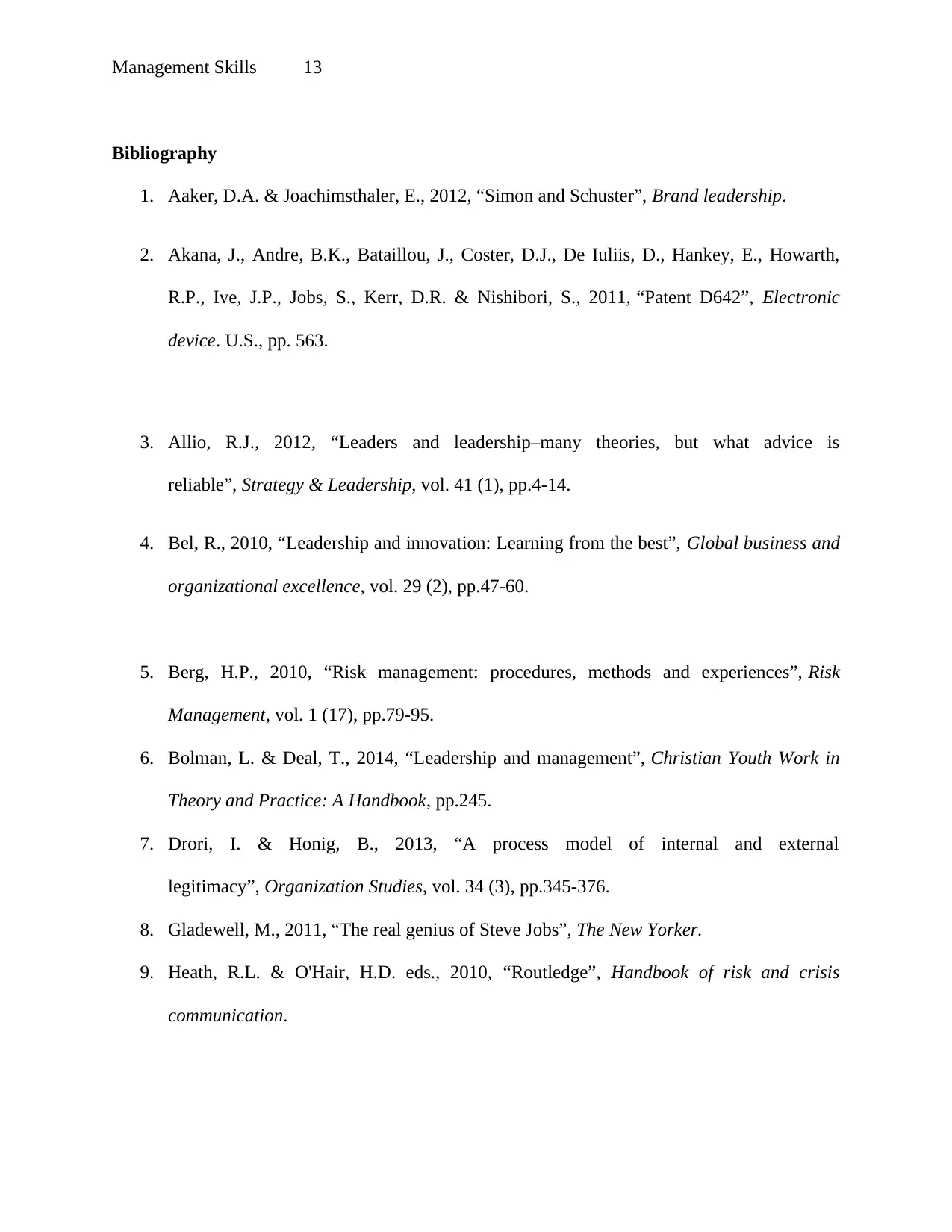
Management Skills 13
Bibliography
1. Aaker, D.A. & Joachimsthaler, E., 2012, “Simon and Schuster”, Brand leadership.
2. Akana, J., Andre, B.K., Bataillou, J., Coster, D.J., De Iuliis, D., Hankey, E., Howarth,
R.P., Ive, J.P., Jobs, S., Kerr, D.R. & Nishibori, S., 2011, “Patent D642”, Electronic
device. U.S., pp. 563.
3. Allio, R.J., 2012, “Leaders and leadership–many theories, but what advice is
reliable”, Strategy & Leadership, vol. 41 (1), pp.4-14.
4. Bel, R., 2010, “Leadership and innovation: Learning from the best”, Global business and
organizational excellence, vol. 29 (2), pp.47-60.
5. Berg, H.P., 2010, “Risk management: procedures, methods and experiences”, Risk
Management, vol. 1 (17), pp.79-95.
6. Bolman, L. & Deal, T., 2014, “Leadership and management”, Christian Youth Work in
Theory and Practice: A Handbook, pp.245.
7. Drori, I. & Honig, B., 2013, “A process model of internal and external
legitimacy”, Organization Studies, vol. 34 (3), pp.345-376.
8. Gladewell, M., 2011, “The real genius of Steve Jobs”, The New Yorker.
9. Heath, R.L. & O'Hair, H.D. eds., 2010, “Routledge”, Handbook of risk and crisis
communication.
Bibliography
1. Aaker, D.A. & Joachimsthaler, E., 2012, “Simon and Schuster”, Brand leadership.
2. Akana, J., Andre, B.K., Bataillou, J., Coster, D.J., De Iuliis, D., Hankey, E., Howarth,
R.P., Ive, J.P., Jobs, S., Kerr, D.R. & Nishibori, S., 2011, “Patent D642”, Electronic
device. U.S., pp. 563.
3. Allio, R.J., 2012, “Leaders and leadership–many theories, but what advice is
reliable”, Strategy & Leadership, vol. 41 (1), pp.4-14.
4. Bel, R., 2010, “Leadership and innovation: Learning from the best”, Global business and
organizational excellence, vol. 29 (2), pp.47-60.
5. Berg, H.P., 2010, “Risk management: procedures, methods and experiences”, Risk
Management, vol. 1 (17), pp.79-95.
6. Bolman, L. & Deal, T., 2014, “Leadership and management”, Christian Youth Work in
Theory and Practice: A Handbook, pp.245.
7. Drori, I. & Honig, B., 2013, “A process model of internal and external
legitimacy”, Organization Studies, vol. 34 (3), pp.345-376.
8. Gladewell, M., 2011, “The real genius of Steve Jobs”, The New Yorker.
9. Heath, R.L. & O'Hair, H.D. eds., 2010, “Routledge”, Handbook of risk and crisis
communication.
1 out of 14
Related Documents
Your All-in-One AI-Powered Toolkit for Academic Success.
+13062052269
info@desklib.com
Available 24*7 on WhatsApp / Email
![[object Object]](/_next/static/media/star-bottom.7253800d.svg)
Unlock your academic potential
© 2024 | Zucol Services PVT LTD | All rights reserved.





